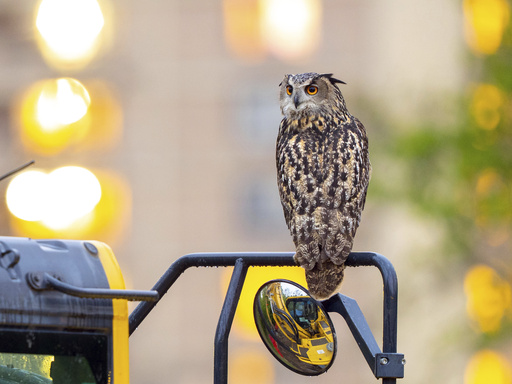New York (AP) — This New York love story begins with a criminal act of sabotage.
Under cover of darkness a year ago Friday, someone breached a waist-high fence and slipped into the Central Park Zoo. Once inside, they cut a hole through a steel mesh cage, freeing a majestic Eurasian eagle-owl named Flaco who had arrived at the zoo as a fledgling 13 years earlier.
Immediately, Flaco fled the park, blinking his big orange eyes at pedestrians and police on Fifth Avenue before flying off into the night.
In the year since his dramatic escape, Flaco has become one of the city’s most beloved characters. By day he lounges in Manhattan’s courtyards and parks or perches on fire escapes. He spends his nights hooting atop water towers and preying on the city’s abundant rats.
To the surprise of many experts, Flaco is thriving in the urban wilds. An apex predator with a nearly 6-foot (2-meter) wingspan, he has called on abilities some feared he hadn’t developed during a lifetime in captivity, gamely exploring new neighborhoods and turning up unexpectedly at the windows of New Yorkers.
“He was the underdog from the start. People did not expect him to survive,” said Jacqueline Emery, one of several birders who document the Eurasian eagle-owl’s daily movements and share them online with his legions of admirers. “New Yorkers especially connect to him because of his resilience.”
But as Flaco enters his second year in the spotlight, it can be easy to forget that his freedom is the result of a crime, one that has improbably remained unsolved.
The break-in happened steps from the shared headquarters of the New York City Parks Department and the Central Park Zoo, in the vicinity of at least one surveillance camera.
But if they have collected any evidence on a potential suspect, police and zoo authorities have declined to share it. Since the zoo suspended efforts to re-capture Flaco in February 2023, there has been no public information about the crime.
Privately, the zoo has sought to soften descriptions of Flaco’s former living conditions, in a minivan-sized structure decorated with a painted mountain vista, barely twice the width of Flaco’s extended wings.
In internal emails obtained through a Freedom of Information request, zoo officials urged the Parks Department not to publicly describe Flaco as “raised in captivity.” Likewise, the term “escape” should be avoided.
“That puts the blame on the animal rather than the perpetrator,” the zoo’s then-communications director, Max Pulsinelli, wrote in one email. “This was a crime.”
In the absence of official information, theories of the crime abound – a youthful prank, perhaps, or an attempted owl heist gone awry? For many invested in Flaco’s fate, the most plausible explanation is that he was freed for ideological reasons.
Proponents of the animal liberation theory point to the seemingly targeted nature of the crime, as well as the limitations of the owl’s modest enclosure.
“I wouldn’t be surprised if it was someone who loved Flaco and wanted him free,” said Nicole Barrantes, a wildlife campaign manager with World Animal Protection, who started a petition against Flaco being returned to the zoo. “His habitat was ridiculous. It was the saddest thing ever.”
Break-ins and vandalism have long been tactics some activists have used to free animals. Such actions are often made public by the North American Animal Liberation Press Office, an anonymous online database.
The group’s spokesperson, Jerry Vlasak, said no one had come forward to claim responsibility for Flaco’s escape. “We never received a communique,” he said. “But we’re certainly glad it happened.”
A spokesperson for the Wildlife Conservation Society, which operates the city’s zoos, did not respond to the claims that Flaco’s zoo habitat was inadequate.
“This was a criminal act that jeopardized the safety of the bird,” the zoo said in a statement, adding that they are continuing to monitor reports of Flaco’s activity and wellbeing and are “prepared to resume recovery efforts if he shows any sign of difficulty or distress.”
Even with his proficient hunting skills, Flaco faces many threats in the city, including a grave risk of consuming rodenticide through a poisoned rat. In 2021, another beloved Central Park owl, Barry, was fatally struck by a truck after ingesting a lethal dose of rat poison that may have impaired her flying.
“All the hazards are still there,” cautioned Suzanne Shoemaker, the director of the Owl Moon Raptor Center in Maryland. “He’s shown some good instincts to be able to make it this far. He’s also lucky.”
Flaco spent his initial months of freedom mostly in Central Park, which is loaded with wildlife, but has lately preferred more urban sections of Manhattan. There has been some speculation that he has been looking for a mate, though he most certainly won’t find one. Eurasian eagle owls aren’t native to North America.
Stories of zoo animals breaking loose in the middle of the country’s densest city have long captured the public imagination, while often ushering in calls for reforms.
Following a series of bird thefts and “senseless” animal beatings in the 1970s, administrators ordered immediate security upgrades and the redesign of some pens at the zoo, which the city’s parks commissioner at the time described as “Rikers Island for animals” because of poor living conditions.
A few years later, when a group of vandals made off with a boa constrictor and a parrot named “Peanuts,” officials accused the perpetrators of stealing the animals for “voodoo rites.”
Since those days the zoo has been substantially redesigned.
Wildlife groups have long warned that owls can be used as sacrifices in certain religious ceremonies — particularly birds like Flaco, who boasts prominent ear tufts. The Eurasian eagle-owl is also commonly used in falconry, selling for as much as $3,000.
But while some have suggested Flaco was targeted for either financial or spiritual purposes, such speculation would seem undermined by the fact that he emerged from his damaged cage and into the bustling cityscape unscathed.
On a recent night on Manhattan’s Upper West Side, one of the Flaco’s most dedicated observers, David Barrett, struck an ambivalent tone when asked how New Yorkers should think about the crime that made him an avian celebrity.
“To me, the folk hero is Flaco,” said Barrett, who runs the X account Manhattan Bird Alert, documenting the bird’s whereabouts in real time. “It’s an amazing thing: He lives his whole life in captivity and in a matter of days he taught himself to fly and to hunt rats.”
Tuning his ears skyward, Barrett listened for the signature hoot that had echoed across Broadway on so many recent nights.
“It’s not our business to try to solve crimes,” he added. “We’re just glad he’s here.”
Source: post





